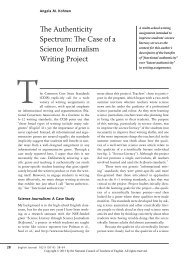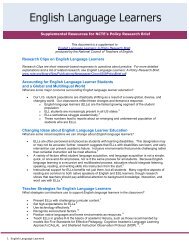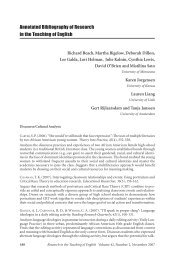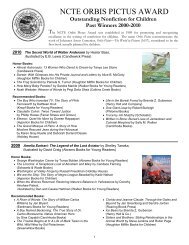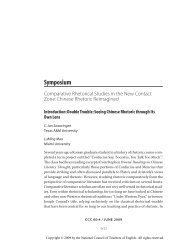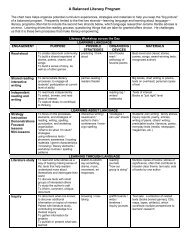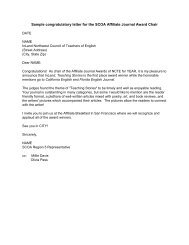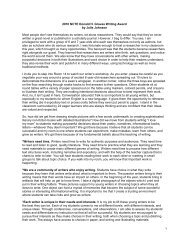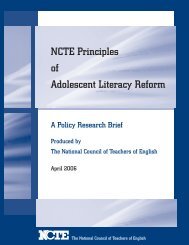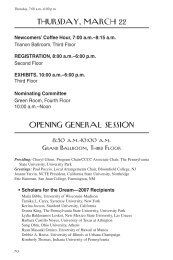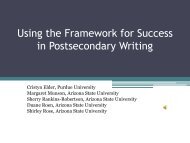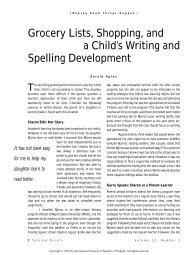Annotated Bibliography of Research in the Teaching of English
Annotated Bibliography of Research in the Teaching of English
Annotated Bibliography of Research in the Teaching of English
- No tags were found...
You also want an ePaper? Increase the reach of your titles
YUMPU automatically turns print PDFs into web optimized ePapers that Google loves.
<strong>Annotated</strong> <strong>Bibliography</strong> 229brought <strong>the</strong>m to school. Stories were <strong>the</strong>n written up and translated <strong>in</strong>to Spanish or <strong>English</strong>,and published <strong>in</strong> a collection. Suggests that connect<strong>in</strong>g with families, build<strong>in</strong>g on funds <strong>of</strong> knowledge,and valu<strong>in</strong>g bil<strong>in</strong>gual literacy <strong>in</strong> <strong>the</strong> classroom enhance students’ <strong>in</strong>tellectual developmentand support bil<strong>in</strong>gualism.FRANCIS, N. (2005). Bil<strong>in</strong>gual children’s writ<strong>in</strong>g: Self-correction and revision <strong>of</strong> written narratives<strong>in</strong> Spanish and Nahuatl. L<strong>in</strong>guistics and Education 16(1), 74-92.Replicates an earlier study that analyzes student self-corrections and revisions <strong>of</strong> narrative compositions.Students <strong>in</strong> this research were fluent <strong>in</strong> Spanish and Nahuatl and had participated <strong>in</strong><strong>the</strong> <strong>in</strong>itial study. Investigates how bil<strong>in</strong>guals might, or might not, apply <strong>the</strong> Common Underly<strong>in</strong>gPr<strong>of</strong>iciency (CUP) (Cumm<strong>in</strong>s, 2000) and “<strong>in</strong>terdependence hypo<strong>the</strong>sis” (Cumm<strong>in</strong>s, 1981,1991). It appears that <strong>the</strong> underly<strong>in</strong>g pr<strong>of</strong>iciencies <strong>of</strong> self-correction and revision from students’national Spanish are evident <strong>in</strong> <strong>the</strong>ir <strong>in</strong>digenous Nahuatl. Confirms missed opportunities<strong>in</strong> formal school sett<strong>in</strong>g when bil<strong>in</strong>guals receive <strong>in</strong>struction <strong>in</strong> one language.MEDINA, C. L., & CAMPANO, B. (2006). Perform<strong>in</strong>g identities through drama and teatro practices<strong>in</strong> multil<strong>in</strong>gual classrooms. Language Arts, 83(4), 332-341.Exam<strong>in</strong>es how students <strong>in</strong> two 5th grade classrooms collaboratively generate knowledge throughdrama. A critical analysis <strong>of</strong> <strong>the</strong> student text, produced through a range <strong>of</strong> dramatic techniques,illustrates how students’ identities and <strong>the</strong>ir understand<strong>in</strong>gs <strong>of</strong> school-based literacy practicescome toge<strong>the</strong>r. Fictional lives and actual lives and identities are explored through drama, giv<strong>in</strong>gstudents dymanic, <strong>in</strong>-between spaces to express <strong>the</strong>mselves. <strong>Research</strong>ers show how students’perspectives and knowledge can be put <strong>in</strong> <strong>the</strong> service <strong>of</strong> students’ own educational and socialempowerment.PRAY, L. (2005). How well do commonly used language <strong>in</strong>struments measure <strong>English</strong> oral-languagepr<strong>of</strong>iciency? Bil<strong>in</strong>gual <strong>Research</strong> Journal 29(2), 387-409.Exam<strong>in</strong>es validity <strong>of</strong> language <strong>in</strong>struments used to test <strong>the</strong> <strong>English</strong> oral language pr<strong>of</strong>iciency <strong>of</strong><strong>English</strong> Language Learners. Subjects for this research are non-Hispanic White and Hispanicnative <strong>English</strong> speakers represent<strong>in</strong>g various socioeconomic levels. Uses frequency and t-testsand ANOVA to compare mean assessment scores and <strong>in</strong>dividual variables and correlations.Concludes that depend<strong>in</strong>g on <strong>the</strong> assessment utilized, native <strong>English</strong> speakers are not scored as“fluent.” Highlights that <strong>English</strong> Language Learners with low scores on <strong>the</strong>se assessments arepoised for academic failures and become unnecessary candidates for special education referral.PROCTOR, C. P., AUGUST, D., CARLO, M. S., & SNOW, C. (2006). The <strong>in</strong>trigu<strong>in</strong>g role <strong>of</strong> Spanishlanguage vocabulary knowledge <strong>in</strong> predict<strong>in</strong>g <strong>English</strong> read<strong>in</strong>g comprehension. Journal <strong>of</strong> EducationalPsychology, 98(1), 159-169.Uses data from a longitud<strong>in</strong>al study <strong>in</strong>volv<strong>in</strong>g 135 Lat<strong>in</strong>o 4th-grade students document<strong>in</strong>g students’acquisition <strong>of</strong> literacy skills <strong>in</strong> Spanish and <strong>English</strong>. Explores relationships among decod<strong>in</strong>gskills, vocabulary knowledge, listen<strong>in</strong>g, and read<strong>in</strong>g comprehension <strong>in</strong> relation to language<strong>of</strong> <strong>in</strong>itial <strong>in</strong>struction. Exam<strong>in</strong>es possible cross-l<strong>in</strong>guistic effects and attempts to add to a holisticmodel <strong>of</strong> read<strong>in</strong>g development for Spanish speakers learn<strong>in</strong>g to read <strong>in</strong> <strong>English</strong>. F<strong>in</strong>ds that orallanguage and read<strong>in</strong>g pr<strong>of</strong>iciencies appear to be strongly mediated by <strong>in</strong>structional language,and that at <strong>the</strong> upper-elementary level oral language pr<strong>of</strong>iciencies exhibit stronger effects onread<strong>in</strong>g comprehension outcomes. Notes a significant relationship between vocabulary knowledge<strong>in</strong> Spanish and <strong>English</strong> read<strong>in</strong>g fluency.REESE, L., GOLDENBERG, C., & SAUNDERS, W. (2006). Variations <strong>in</strong> read<strong>in</strong>g achievement amongSpanish-speak<strong>in</strong>g children <strong>in</strong> different language programs: Explanations and confounds. TheElementary School Journal, 106(4), 363-385.



